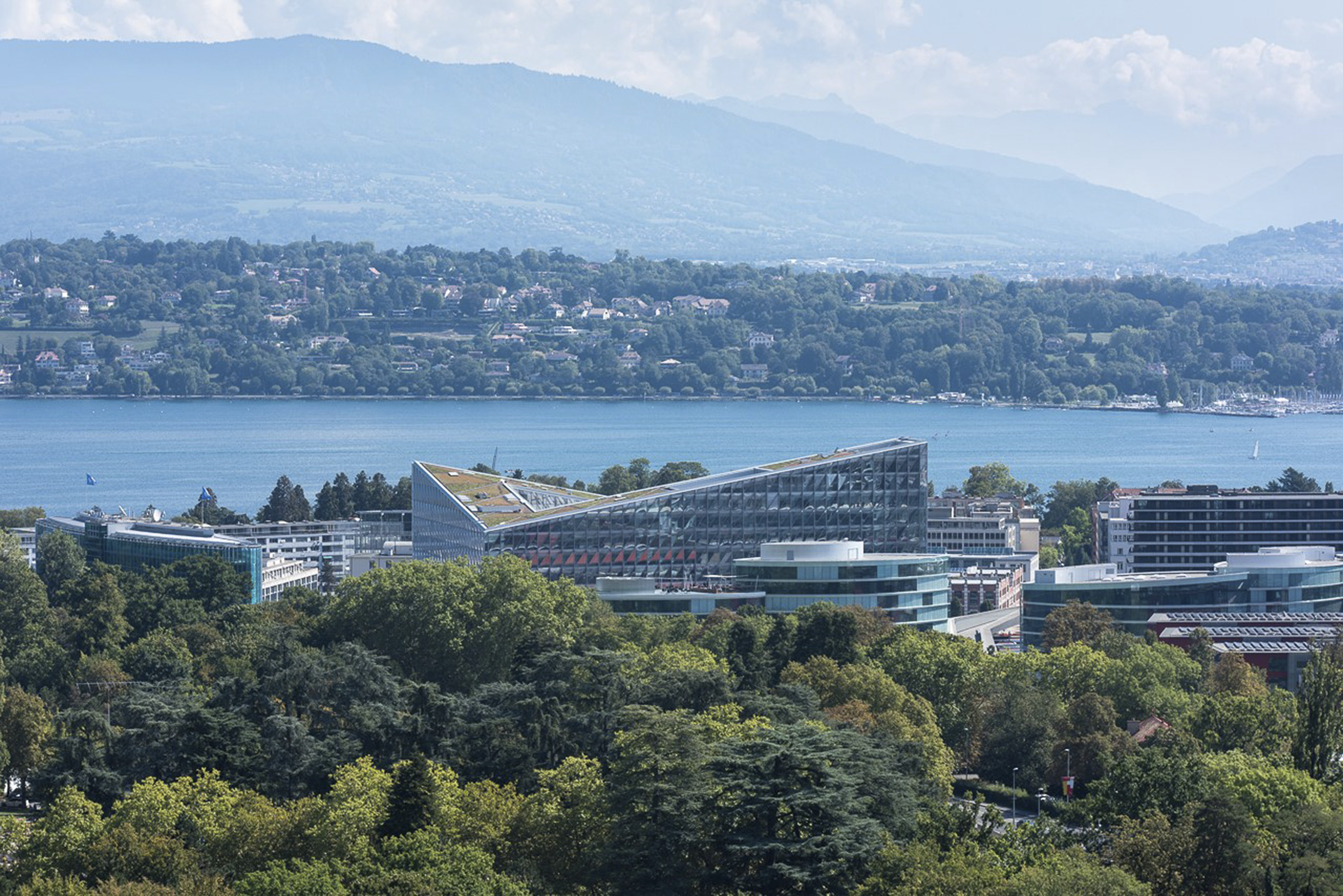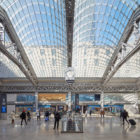Even in construction, the new County Office Building (COB3) in downtown Redwood City is turning heads. Planks and beams of mass timber, rather than steel or concrete, form the five-story building’s structure, visible to all who pass by the building site.
Mass timber has become an emblem for sustainable architecture for its low carbon footprint, and new legislation has facilitated its deployment in California in recent years. San Mateo County, which includes the northwestern portion of Silicon Valley, aimed to set a benchmark with its latest building project — not only in terms of the building’s energy use, but also the carbon impact associated with its construction.
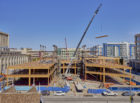
By using timber, a renewable material that can be sourced domestically, the design of COB3 achieves an impressive 85 percent reduction in structural embodied carbon, relative to conventional concrete or steel construction. The result: COB3 is the first net-zero-energy mass timber civic building in the United States.

Involved in every aspect of the design and construction process, SOM’s integrated team of architects and engineers showed that timber can be a cost-competitive choice, even for publicly-funded projects. In this interview, three project leaders — structural engineer Eric Long, technical architect Francesca Oliveira, and timber specialist Benton Johnson — tell the story behind the design of California’s greenest new civic building and share their thoughts on the future of timber construction.
How was the decision made to use timber as the structural material for the new County Office Building?
Francesca Oliveira: San Mateo County is already seeing the impact of climate change — from sea level rise to wildfires, severe drought, and extreme heat. The County is asking its citizens to build more sustainably, and for their own new government building, County officials saw this as an opportunity to lead by example.
Net-zero energy was a project requirement from the beginning, but we challenged our client to be even more ambitious. In addition to targeting net-zero operational energy, we proposed to also reduce embodied carbon — the up-front carbon cost related to building materials and construction. We wanted to treat reducing carbon impact as a holistic goal, examining not just operational practices, but also finding opportunities to use the latest advances in low-carbon materials and construction processes.
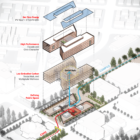
Eric Long: We arrived at the solution of a timber structure after a careful study of several different options. We laid out concepts, designing the building as steel, concrete, and timber structures. Because of the way we work at SOM — with engineers and architects collaborating from the outset of a project — we were able to understand in real time how each structural concept would pair with the shape and massing of the building. Then, looking at each of those options, we were able to measure the structural materials required and the associated embodied carbon. The timber option showed an 85 percent reduction in structural embodied carbon relative to the steel and concrete options that we had designed.
The contractor was already on board when we first started, and that was a benefit to our process. With our three options of concrete, steel, and timber, we knew the material quantities and we knew the carbon impact. Now, thanks to the contractor, we also knew the cost. We were able to lay out for the client what the choices were, and we were able to show that timber was within budget. When reducing embodied carbon is the priority, the choice becomes obvious.
Francesca: A common critique of mass timber is that it’s more expensive, and we disproved that by optimizing our design to reduce both the amount of wood and the number of pieces that were required. We measured everything, down to the pick counts — how many times you have to lift planks and beams with a crane.
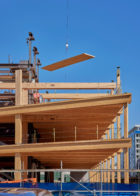
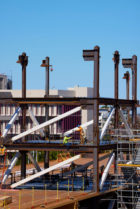
When you account for all of these details, the speed with which a mass timber structure can be installed is incredible. It was exciting to watch the mass timber installers literally chasing the steel core framers. The mass timber was going up so fast, they’d have to stop and wait to just fasten screws while the steel cores were still being welded. It was really fun to see this friendly competition in the field, and this shows us an enormous opportunity for construction when one considers the time value of that installation. That’s another reason that timber will gain momentum in the market.
Benton Johnson: If you want to reduce the embodied carbon footprint of a building, you want to start with the structure — that’s the biggest contributor. Once you get down to hardware or door handles, it’s a much smaller piece of the carbon footprint. We want to focus our efforts on where we can make the greatest impact. SOM’s design approach is based on integrating architecture and engineering, and that puts us in a unique position to find high-impact solutions.

For a building of this scale, in a high seismic zone, you would expect 50 or 60 percent of the embodied carbon to be in the structural frame and foundations. And because timber is very lightweight, it also requires less structural material to support it. So, we were able to pair the timber structure with a very ductile steel core and thereby further reduce the material required for the foundations. It’s a kind of domino effect in material efficiencies and carbon savings.
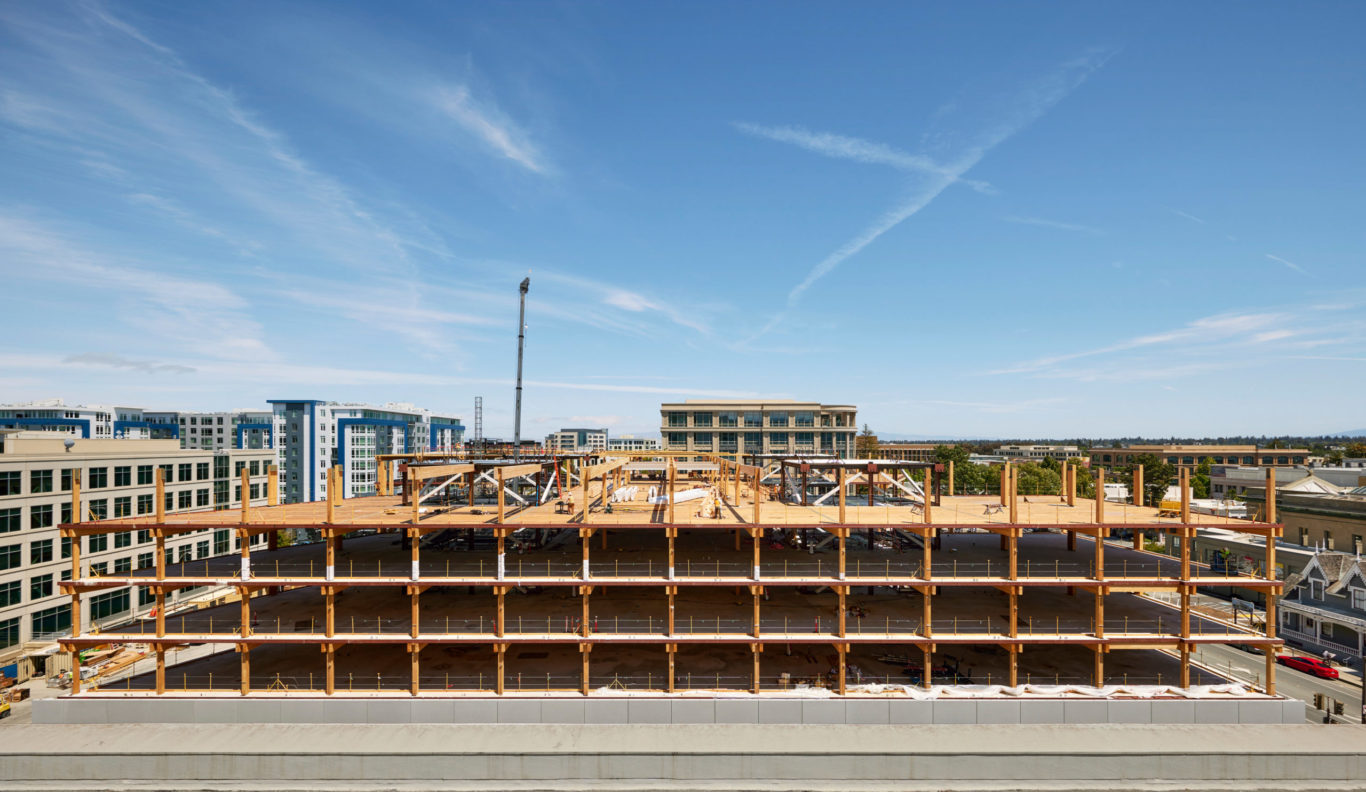
Demonstrating that timber construction can be cost-competitive sounds like a breakthrough. Tell us about how you optimized the timber design to make it more efficient.
Eric: Optimization starts with the bay size — the typical spacing between structural columns. We started by asking, what is the bay size that works best for this building? We considered the module of the office spaces, among many other factors, and sketched a multitude of possible bay configurations. Then we looked at how many glulam beams and what thickness of cross-laminated timber (CLT) panels were required for those different bay configurations.
Working closely with our contractor, we were able to price the pieces and connections in real time as we were studying the bay-sizing options. Our solution was ultimately to reduce the number of beams and have them run in only one direction, which in turn reduces the number of pieces and connections and creates an efficient bay size that works well with the office layouts.

By running the beams in only one direction, it created a more efficient ceiling/floor structure by integrating the MEP distribution parallel with the beam direction, which allowed us to reduce the typical floor-to-floor height and the overall building height. This contributed to further savings in cost and carbon.
Francesca: Our interdisciplinary team approach was key to the success of this project. Eric, as our structural engineer, worked very closely with our architects and interior designers to holistically develop each design decision for the systems, the structure, and the people who will use the building. This was intricate work, and together we found opportunities for these decisions to build off each other; for example, shifting to beams going only in one direction enabled us to optimize our MEP system distribution. Through close collaboration, we were able to design a systematic framework for all of the building engineering that was married together with the interiors and architecture. It speaks to SOM’s philosophy: every team member contributes to the design solution — not only the architecture and engineering team, but the client and the contractor as well.
Benton, you’ve led years of research at SOM on timber construction. What have we learned through these efforts, and how did we apply it in San Mateo County?
Benton: A big focus of our research has been on finding ways to make timber buildings compatible with the market. When you’re talking about a mass timber structure, that means looking carefully at how the members are spaced in three dimensions — bay sizes and ceiling heights. So for this building, one of the first questions we asked was: how do we create open floor plans with the least bulky structure? The bay size that we have for this project, at 20 by 35 feet, is pushing the limits on a timber structure.

We were able to make this work by making the main girders continuous over the center supporting columns. The weight of the bays on each side is balanced, which lets the structure support itself more easily. We were able to achieve those 35-foot-long spans with relatively shallow beam depths (just over two feet), which reduces structural cost and floor-to-floor height.
It’s also interesting to look at how we connected the CLT planks to each other. They’re spliced at their ends, so that they are continuous throughout the entire floor. We used tension splices on the top sides of the planks — this technique makes the decks stronger and more resilient against seismic events. Again, that draws from the ideas behind our research: figuring out how to maximize the benefits of a timber structure without breaking the bank.
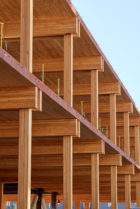
Francesca: There are additional benefits to the way we have designed the structure: a 60- or 65-foot bay is great for occupants because it allows for natural light and ventilation from both sides. It’s a win-win. Our San Mateo County Office Building proves that using mass timber can be an elegant design solution, and that it can create beautiful architecture within a tight schedule and an even tighter budget.
Benton: Knowing that this building will be used by county employees and members of the public, often for long hours, we also want to make spaces that boost well-being. Biophilia — the principle that humans are innately attracted to nature — is a really important positive aspect of timber buildings. Wood adds warmth, and it will feel good to spend time in these spaces.
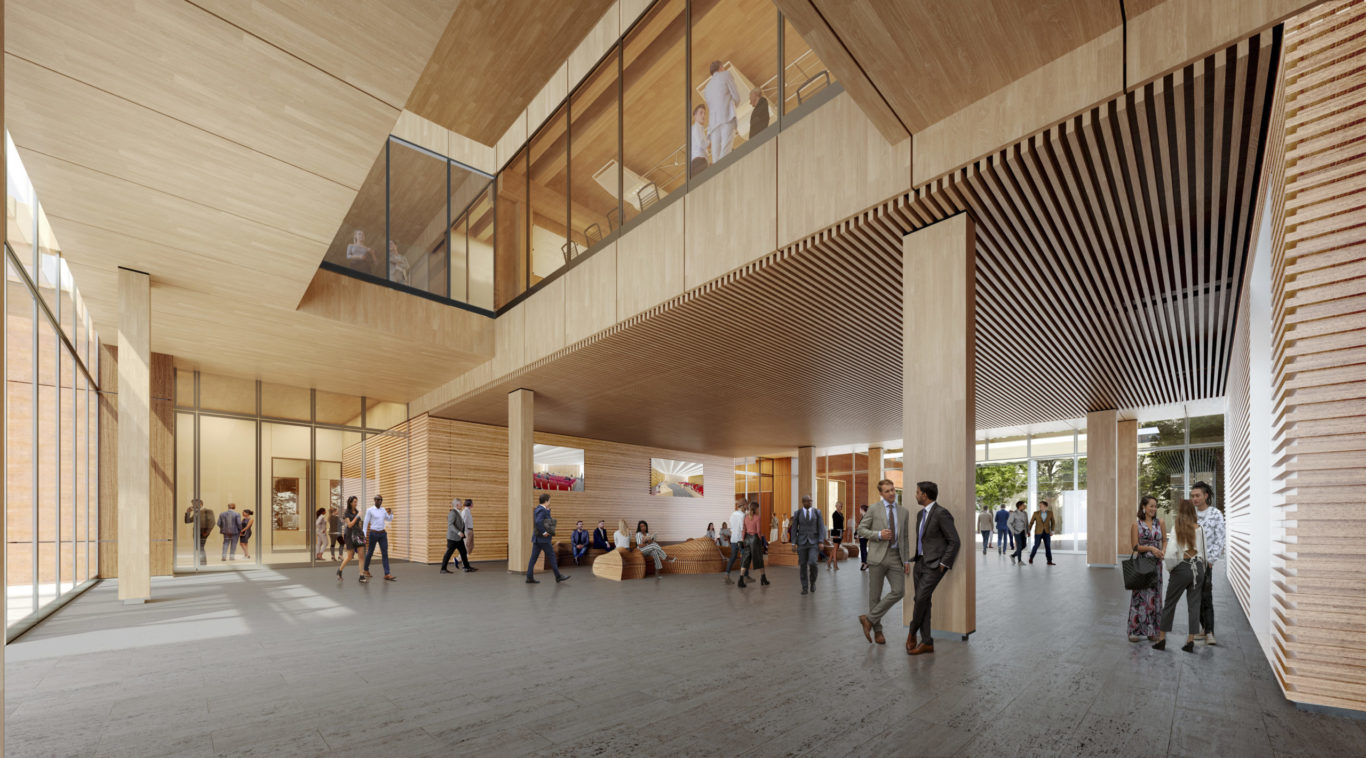
What were some of the challenges you encountered along the way?
Eric: A project like this requires an incredible amount of coordination — with acoustics, lighting, mechanical, electrical, plumbing, you name it. Every electrical outlet, light fixture, and fire sprinkler is pre-manufactured into the wood in the shop. There’s no ceiling to cover mistakes; it’s all exposed. For our subcontractors, this may have been their first time working on a heavy timber building, so we were also helping the MEP trades with pre-planning for all of those details. Every one of these projects helps the next one get built more smoothly — it’s a relatively new field and we’re improving the process each time.
Francesca: That’s a really important point: we were able to remove 70 percent of the ceilings in this building, which is a lot for an office! That saved almost 500 tons of CO2eq, which in most building projects would have been spent just to hide MEP infrastructure. When you remove that ceiling, every component has to be designed; it’s finished work that you’re seeing on the underside of the structural slab. Now, all the engineering trades are part of the design expression.

We took this a step further to ask, what happens in the future, if the County needs to adjust the floor plate because office sizes have changed, or workstations have shrunk? The structural bays that we designed can be configured in different ways: there could be four closed offices, or two closed offices and four workstations. Those four workstations could become six workstations. The County can create any combination, with minimal changes to the infrastructure and its carbon impact. We want this building to serve for 100 years and to be adaptable over time, so that flexibility is designed and built in from day one.
What are the challenges and opportunities ahead for timber construction being adopted more widely?
Benton: If you’d asked me that six years ago, I would have given you a long list. But today we’re reaching a tipping point. Ramping up the scale of the manufacturing is important because the lead times can be long, but we are lucky to be working in a part of the country where timber is available and sustainably sourced.
Francesca: There is still a lot of myth-busting that needs to be done. As architects, we advocate for mass timber by partnering closely with fire marshals and authorities having jurisdiction to build a broader understanding of the performance characteristics of this low-carbon construction type. As this awareness grows, it will become easier for clients to choose timber.
Benton: We’re also finding new, efficient ways to standardize construction. For example, we’ve been advocating for long-span and continuous systems — moving away from stacked post-and-beam construction, and getting to slim construction with tight floor-to-floors — and we’re starting to see others adopting that now, too. As things become more standardized, there will be smaller barriers to entry for contractors and clients who want to pursue timber. We’re excited to be at the cutting edge of this field that we expect will grow significantly in the near future.

Eric: On the client side, there’s still a hurdle in terms of perceived cost. A common perception is that the premium on timber is prohibitive.
Benton: This is somewhat regional. On the West Coast, generally the cost of construction is a bit higher than in the rest of the U.S. Part of the challenge with adoption on a larger scale is getting to cost parity throughout North America. Another part of it is regional supply. We’ve been seeing more manufacturers start to open up in the southeast, and that’s going to shift things a lot as they create access to those lower-cost markets.
With timber gaining momentum, how often are you proposing this option when you’re starting a new project?
Eric: Frequently. When we start working with a client, straight away we ask questions to understand their sustainability goals and, if appropriate, if they are interested in looking at mass timber as an approach to reduce embodied carbon. Usually the answer is a resounding yes. In very early design stages, we can conceptually design the architecture and structure in a variety of materials, develop a quick rendering, see what the space feels like, look at the quantities and carbon savings, and get cost information. We aim to provide our clients with the information to make an educated decision; that’s our responsibility as architects and engineers.
Benton: Mass timber is a solution that can work for just about any building type, in any climate. Compared to building with concrete and steel, timber construction is incredibly efficient. It doesn’t matter if it’s hot, cold, raining, or snowing. Steel construction can be difficult in extreme temperatures, because things don’t align when the members expand and contract. With concrete construction, when it’s in the middle of winter and freezing, you have to tent it and heat it. When it’s really hot out, you’ve got to put ice chips in the concrete mix. With timber construction, if it gets wet, you just squeegee it off and keep going. It’s faster than anything else to start with, and there’s nothing that slows it down.
